Health care IT comes with its own unique set of stipulations. From protecting sensitive data to aligning with HIPAA guidelines and preventing cyber threats, maintaining your IT needs can feel like a whole other job — when what you really need to be focusing on is your patients.
When you partner with a managed services provider (MSP), you’re free from the burden of IT problems. We’re here to ensure that your data and networks — and therefore, your patients — are constantly protected. Here’s how managed IT services and voice over internet protocol (VoIP) will help you manage complex and critical IT needs for your health care organization.
Managed Services for Your Health Care IT
Every health care institution needs a business continuity plan to protect against network outages, natural disasters or cyber threats. With strategic planning and proactive monitoring, we’ll help you reach your business goals while protecting you against risks to keep you competitive and successful.
- Get cybersecurity peace of mind. As a health care organization, you handle confidential information each and every day, from patient and HR records to strategic planning documents and corporate financial data. If any of this data were to be lost, leaked or compromised, you could risk HIPAA noncompliance and face damaging consequences to your organization. When you partner with a managed services provider, you have the peace of mind that your data is protected from leaks and ransomware. Our built-in encryption, redundant backups and multiple storage locations ensure that your data is protected from harm, keeping it secure, updated and instantly retrievable.
- Stay HIPAA compliant. As a member of the health care community, you know that meeting HIPAA compliance regulations is vital to ensure data security. Failure to meet these mandates can result in tremendous fines, potentially damaging penalties and even revocation of your license. When you partner with an MSP, however, you benefit from identity-based security and encryption, authorized privileges and access control, and data accountability and integrity.
- Rest assured with disaster recovery. An MSP offers cloud backup solutions to safeguard your data in the event of a security breach or natural disaster. All data is fully encrypted, copied and saved at an off-site data center so that it’s constantly protected and backed up in real time. Should an emergency occur, your data and resources would be instantly available, without the downtime of waiting for file recovery or backup hardware.
How VoIP Optimizes Your Health Care IT Communications
When you work in a health care organization, you’re never in one place for too long. As a physician or administrator, you’re constantly changing locations, from assisting patients in various rooms, running back to your desk or office, and all the in-between. That’s why you need a technology-forward unifying communications solution for all staff to be able to access at any time, from anywhere. VoIP offers just that, allowing voice calls to be made over IP networks in real time. By using the internet rather than a traditional landline, your communications are faster, more reliable and accessible from any location.
All your calls, chats and video conferences can be conducted on any computer or mobile device, so that physicians and staff can maintain constant contact with patients and with each other in real time. Communicate internally through quick extension and click-to-call dialing or video conference. Best of all, you can use any phone or mobile device and maintain the same phone number, extension, speed dials and voicemail.
Here at Taylored, we’ve had plenty of health care IT experience, so we understand the regulatory and critical requirements your organization faces. When you partner with us, we offer integrated IT security and data solutions to mitigate risks and make your entire IT infrastructure more safe and efficient. Contact us today and let us optimize your IT infrastructure for a more competitive and successful future.

